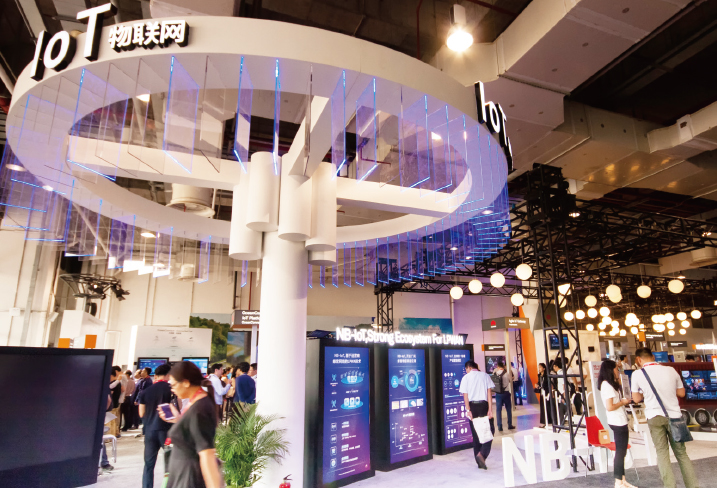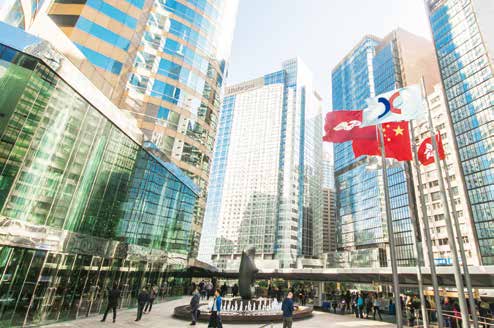The “14th Five-year” Plan has clearly expressed the Country’s support for Hong Kong in developing in eight aspects. By fortifying and raising its status as an international financial hub, for example, Hong Kong can leverage its financial strengths to complement the national “dual circulation” strategy and play an important role in China’s financial opening.
E Zhihuan: Hong Kong’s Financial Industry has an Edge under the New Economic Layout
 COVID-19 has not only redefined the layout of the global economy, but also brought about additional uncertainties to its future. E Zhihuan, Chief Economist of Bank of China (Hong Kong), believed that the future trajectory of the global economy will be affected by three main factors. The first is concerned with the impact of the pandemic. “COVID has lingered on for more than two years, but its influence is still very profound. The global economy is now polarized. As countries are recovering in their own different pace, such polarization is expected to worsen.”
COVID-19 has not only redefined the layout of the global economy, but also brought about additional uncertainties to its future. E Zhihuan, Chief Economist of Bank of China (Hong Kong), believed that the future trajectory of the global economy will be affected by three main factors. The first is concerned with the impact of the pandemic. “COVID has lingered on for more than two years, but its influence is still very profound. The global economy is now polarized. As countries are recovering in their own different pace, such polarization is expected to worsen.”
Secondly, economic recovery around the world is heavily relying on the facilitation of macroscopic policies. Particular attention should be placed on US monetary policies. According to the analysis of E, as the overall US economy is recovering more quickly than the European one, some inflation pressure is inevitable and preparation for balance sheet reduction is underway. Rate hikes, an unfavorable factor for global economic recovery, may come around sooner. Geopolitical risks would be the last factor. E explained that the current trade dispute between China and the US is entering a new phase, and the market is rather anxious about the decoupling of the Chinese and US economies. Political uncertainties will bring some negative impact to the economy.
Hong Kong’s finance sector revitalized by the “14th Fiveyear” Plan
E added that Hong Kong could ride on its unparalleled geographical location and benefit from the country’s expedited development, thanks to the “dual circulation” concept proposed in the “14th Five-year” Plan. “Hong Kong will establish eight major centers and this direction is supported by the ‘14th Five-year’ Plan. Hong Kong now enjoys a new point of entry to integrate into the national development. The Greater Bay Area strategy also provides an even larger hinterland for Hong Kong, opening up broadened room for development for Hong Kong’ financial industry.”
Speaking of the overall industrial layout of the 9+2 Greater Bay Area cities, E explained that each Greater Bay Area city has its own clearly defined position and role. Accelerated integration of the Greater Bay Area would lend stronger support to the Hong Kong economy. “The solutions of Hengqin and Qianhai, which were recently launched, are worth noting. Many pragmatic and effective measures were raised for the reform and innovation of the Chinese economy. The economic aggregate is expected to make up 18% of the China’s GDP by 2035.”
Hong Kong financial industry stands out and shines
 Hong Kong has built for itself a first mover advantage and a scale advantage for RMB internationalization businesses after years of development. With regards to the international asset management business, the financial industry of Hong Kong will be blessed with rich offerings following the launch of as Cross-boundary Wealth Management Connect. The territory’s experience accumulated from the insurance sector, on the other hand, is expected to help Hong Kong gain another edge in building global risk management business.
Hong Kong has built for itself a first mover advantage and a scale advantage for RMB internationalization businesses after years of development. With regards to the international asset management business, the financial industry of Hong Kong will be blessed with rich offerings following the launch of as Cross-boundary Wealth Management Connect. The territory’s experience accumulated from the insurance sector, on the other hand, is expected to help Hong Kong gain another edge in building global risk management business.
Hong Kong has overtaken Singapore and reclaimed the rank of the world’s third biggest global financial hub in recent years. E saw that Hong Kong could assume a more important role in liberalizing China’s external financial market. “As a financial hub, Hong Kong is characterized by a highly internationalized banking industry. Hong Kong is a city with the biggest number of banks from around the world. The market is also very transparent. Added with its world-leading regulatory mechanism and sound legal system, Hong Kong’s competitiveness does make it stand out and shine.”
Li Luxia: Hong Kong is a Financial Super Connector
 Putting its unique economic status into full play, Hong Kong has become the one and only “super connector” that bridges China with the international market. According to Li Luxia, Deputy General Manager of Strategic Planning and Investment Management, ICBC (Asia), this role is inseparable from Hong Kong’s own fortes. “China has re-exported HKD 37.6 trillion worth of goods via Hong Kong since the reunification. At the same time, Hong Kong is the biggest source of investment for the Chinese mainland, accounting for 56% of all foreign investment in China.”
Putting its unique economic status into full play, Hong Kong has become the one and only “super connector” that bridges China with the international market. According to Li Luxia, Deputy General Manager of Strategic Planning and Investment Management, ICBC (Asia), this role is inseparable from Hong Kong’s own fortes. “China has re-exported HKD 37.6 trillion worth of goods via Hong Kong since the reunification. At the same time, Hong Kong is the biggest source of investment for the Chinese mainland, accounting for 56% of all foreign investment in China.”
“深圳前海蛇口片區、珠海橫琴新區和廣州南沙新區共同組成了廣東自貿區,而上述兩個方案都是在廣東自貿區的特殊環境中再開放、擴展。”王緝憲續指出,澳門在橫琴方案中擁更大的話語權,經濟項目以澳門為主導;而前海方案的內容包括“打造全面深化改革創新試驗平台”、“建設高水平對外開放門戶樞紐”等,則由深圳主導,“雖然中央政府沒有將前海方案的發展主導權交給香港,但強調港深協同發展,雙方需要加強合作。”
Connector role cemented by “dual circulation”
The “dual circulation” strategy and other recently proposed policies will further strengthen Hong Kong’s connector role. Li pointed out that Hong Kong has long been an important hub in the “external cycle” of the Mainland economy. For example, Hong Kong has signed multiple agreements with “Belt and Road” countries in recent years, in hopes to continuously exert its function in cross-border investment and financing activities for countries involved in the initiative. Furthermore, RCEP has also created a new landscape for a unified APAC region. The Ministry of Commerce has already expressed its support for Hong Kong’s early entrance.
As for the “internal cycle”, with the Greater Bay Area integration speeding up, Hong Kong’s pillar service industry is expected to align with the Mainland economy. “While Hong Kong is one of the most developed service industry capitals in the world, highend services are still only attributable for a small proportion in the nine cities of the Greater Bay Area. The complementary strengths of Hong Kong and the nine cities will be fostered by the formation of the Greater Bay Area.” In the scope of innovation and technology, Li commented that Hong Kong’s tertiary institutes, research institutes and companies could turn their research outcomes into marketized offerings in the Mainland. A development layout underpinned by specialized industrialization, education and research can be established.
A hub in China’s financial opening
 Li thought that as Hong Kong seized the opportunities in the Country’s reform and opening-up, its status as a financial center also continued to rise. Hong Kong has also been functioning as a hub in the country’s financial opening. “Hong Kong is the first stop to run cross-border operations for China’s financial industry. Over the past five to ten years, a huge number of China-funded banks began operating in Hong Kong.”
Li thought that as Hong Kong seized the opportunities in the Country’s reform and opening-up, its status as a financial center also continued to rise. Hong Kong has also been functioning as a hub in the country’s financial opening. “Hong Kong is the first stop to run cross-border operations for China’s financial industry. Over the past five to ten years, a huge number of China-funded banks began operating in Hong Kong.”
Hong Kong is also the world’s largest offshore RMB hub, with the biggest offshore RMB capital pool. At the same time, Hong Kong is the preferred platform for new economy companies to get listed and to acquire financing. “In 2018, the HKEX implemented listing reform to broaden financing opportunities for new economy companies. More than half of the companies currently listed on the HKEX are from the mainland, and they are accounting for more than 80% of the market’s capital. The numbers are a testament to the extremely strong appeal of Hong Kong’s financing market.”
Sally Wong: Hong Kong to Give a Hand in RMB Internationalization
 Acco rdi ng t o Sal ly Wong, Ch ief Executive Officer of Hong Kong Investment Funds Association, Hong Kong’s demand for RMB products has been rising in recent years. She explained that public funds refer to funds that are authorized by the Securities and Futures Commission of Hong Kong. This year, investments are made on some 50 RMB denominated underlying products. “The number itself may not seem to be impressive. Yet, there are many channels for Hong Kong or international investors to invest on RMB products. Besides, there is even a specific RMB category in public funds.”
Acco rdi ng t o Sal ly Wong, Ch ief Executive Officer of Hong Kong Investment Funds Association, Hong Kong’s demand for RMB products has been rising in recent years. She explained that public funds refer to funds that are authorized by the Securities and Futures Commission of Hong Kong. This year, investments are made on some 50 RMB denominated underlying products. “The number itself may not seem to be impressive. Yet, there are many channels for Hong Kong or international investors to invest on RMB products. Besides, there is even a specific RMB category in public funds.”
Rising demand for RMB products
“Although the category is termed RMB, this kind of public funds do not necessarily directly invest on RMB assets.” Wong noted that rapid growth in this type of funds. There were only 200 in 2019; today, there are about 300 of them. She also reckoned that this type of products are significant because RMB assets do not have to be the underlying assets for promoting RMB internationalization. Instead, RMB can be used to invest in other products.
Hong Kong’s role strengthened through Cross-boundary Wealth Management Connect
Wong foresees growth in the number of similar funds. In the future, mainland clients will mostly invest on Hong Kong’s wealth management products through this channel, i.e. using RMB to purchase and invest on various products from around the world. This will be especially important for promoting RMB as an investment instrument.
“In fact, this also reflect the importance of Hong Kong from another direction. According to the figures from the Securities and Futures Commission, investment on the Mainland’s market represent 21% of all assets managed in Hong Kong last year, marking a growth of 47% compared with the previous year. When Shanghai-Hong Kong Stock Connect and Shenzhen-Hong Kong Stock Connect first commenced operation, only 10 to 15% of overseas investors made use of the mechanism for investing in the A-shares of China. That number has now risen to 70%, which is a true testimony to the unique ‘super connector’ role that Hong Kong plays.”
Continuous refinement of connectivity arrangements
In the future, Hong Kong will be the intermediary of choice for overseas investors investing in the Mainland, or mainland investors allocating their assets overseas. Wong opined that connectivity arrangements between Hong Kong and the Mainland should be expedited to address the increasing demand. “In the past, certain requirements of the mutual recognition of funds between Hong Kong and the Mainland may be too stringent. As a result, foreign funds did not know how to participate. It is hoped that this experience could shed light on refining other detailed arrangements.
Wong stressed that medium- and lowrisk products are the only options provided in the current Cross-boundary Wealth Management Connect mechanism. To truly meet the asset allocation demand of mainland investors, the full range of low- , medium- and high-risk products must become available in the future. Besides, if the Greater Bay Area is developing towards a singular market direction going forward, mutual qualification recognition and other systemic arrangements between Hong Kong and Mainland practitioners must be perfected as soon as practicable, such that interconnectivity can be continuously optimized in the legal and operational levels.




